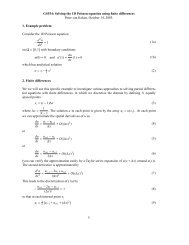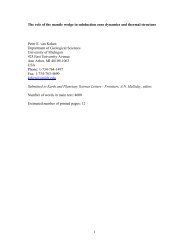Quantitative paleoenvironmental and paleoclimatic reconstruction ...
Quantitative paleoenvironmental and paleoclimatic reconstruction ...
Quantitative paleoenvironmental and paleoclimatic reconstruction ...
You also want an ePaper? Increase the reach of your titles
YUMPU automatically turns print PDFs into web optimized ePapers that Google loves.
ARTICLE IN PRESS<br />
30 N.D. Sheldon, N.J. Tabor / Earth-Science Reviews xxx (2009) xxx–xxx<br />
Fig. 18. δ 18 O values of meteoric precipitation (black line), soil moisture at 10 cm, <strong>and</strong> soil moisture at 60 cm depth in a modern soil profile in Ellensburg, Washington U.S.A., versus progressive<br />
days of analysis (Robertson <strong>and</strong> Gazis, 2005). The shallowest sample level (10 cm) of the profile has soil water δ 18 Ovaluessignificantly more positive (~9‰) δ 18 O values than that of mean<br />
annual precipitation values, whereas the deepest sample level (60 cm) of the profile has δ 18 O values very near that that of the mean δ 18 O value of precipitation. See text for discussion.<br />
(Tabor <strong>and</strong> Montañez, 2005; Tabor 2007). Because of all of these factors,<br />
paleosol calcite δ 18 O values should probably be avoided as a proxy of<br />
paleotemperature.<br />
7.3.2. Pedogenic siderite as a proxy for soil moisture δ 18 O values<br />
Pedogenic sphaerosiderites exhibit δ 18 O values ranging from ~0‰ to<br />
−18‰ (PDB; Baker et al.,1996; Ludvigson et al.,1998; White et al., 2001;<br />
Ufnar et al., 2002, 2004). However, siderite δ 18 O values typically exhibit<br />
a narrow range of intra-profile values (b2‰), which is interpreted to<br />
reflect relatively stable (invariant) temperatures <strong>and</strong> mean δ 18 Ovalueof<br />
local groundwater that flood the soil profile (Ludvigson et al., 1988;<br />
White et al., 2001; Ufnar, 2002, 2004). Nevertheless, because the δ 18 O<br />
value of siderite is related to two variables (T <strong>and</strong> δ 18 OofH 2 O), one<br />
variable must be assumed, or determined by an independent means, in<br />
order to determine the other (as is the case with pedogenic calcite). In<br />
their treatment of sphaerosiderite δ 18 O values from paleosols that<br />
defined a mid-Cretaceous paleolatitudinal transect from ~35° to 55°N,<br />
White et al. (2001; Ludvigson et al., 1998; Ufnar et al., 2002, 2004)used<br />
the predicted mean annual surface air temperatures from General<br />
Circulation Models (GCM) for Middle Cretaceous time (Barron, 1989;<br />
Barron et al., 1989; Poulsen,1999) in order to estimate groundwater <strong>and</strong><br />
meteoric precipitation δ 18 O values. Sphaerosiderite δ 18 O values indicate<br />
significantly more negative δ 18 O values (4.0–4.3‰) of mid-Cretaceous<br />
meteoric precipitation than modern isolatitudinal sites. Based upon the<br />
well-known relationship in the modern hydrological cycle, that coastal<br />
precipitation shows ~− 2‰ shift for every additional 100 mm of<br />
precipitation per month, White et al. (2001) hypothesized that these<br />
sphaerosiderite-producing soils formed in the presence of ~2400 to<br />
~2600 mm of precipitation per yr along the coastlines of the North<br />
American Cretaceous interior seaway.<br />
Other examples of sphaerosiderite in paleosol profiles have been<br />
described from high-latitude Permo-Carboniferous (Brown <strong>and</strong> Kingston,<br />
1993; Faure et al., 1995) <strong>and</strong> Triassic strata (Retallack, 1976) as<br />
well as tropical Paleogene strata (Jacobs et al., 2005; Fig. 17). They<br />
typically occur in clastic strata that are associated with coal measures.<br />
In this regard, sphaerosiderite may be an abundant paleopedogenic<br />
mineral in both time <strong>and</strong> space, which is limited to poorly drained<br />
environments, <strong>and</strong> that has gone largely unnoticed as a useful proxy of<br />
paleoclimate. If so, δ 18 O values of paleopedogenic sphaerosiderites<br />
have the potential to become an important paloeclimate proxy which<br />
represents pedogenic environments that are generally exclusive of<br />
pedogenic calcite.<br />
7.4. δ 13 C values of soil carbonate<br />
7.4.1. Calcite from one-component of soil CO 2<br />
The closed-system, one-component soil CO 2 model of calcite<br />
crystallization is not normally considered in soil systems, but is<br />
frequently associated with early diagenetic marine <strong>and</strong> lacustrine<br />
calcites that are characterized by very negative δ 13 C values (e.g., Irwin<br />
et al., 1977; Gluyas, 1984; Scotchman, 1991). Calcites that precipitate<br />
via one component, chemically closed or semi-closed, conditions will<br />
have δ 13 C values no more than 14.8‰ heavier than in situ soil organic<br />
matter. This reflects that open-system oxidation of soil organic matter,<br />
in the absence of contribution of isotopically heavier CO 2 from the<br />
global troposphere, results in (at least) 4.4‰ diffusive enrichment,<br />
<strong>and</strong> an additional ~10.4‰ carbon isotope enrichment from gaseous<br />
CO 2 to calcite due to carbon isotope fractionation between carbonate<br />
species (at mildly alkaline pH; Bottinga, 1968).<br />
Evidence for calcite formation in the presence of one soil CO 2<br />
component is sparse. However, a study of waterlogged soils in the<br />
Atchafalaya Swamp, Louisiana, U.S.A. demonstrated that calcite δ 13 C<br />
values can be less than − 20‰, <strong>and</strong> therefore did not crystallize under<br />
open-system exchange with tropospheric CO 2 (Whelan <strong>and</strong> Roberts,<br />
1973). In this regard, calcite precipitation in the presence of one soil<br />
CO 2 component may be a reasonably common occurrence in swampy,<br />
waterlogged soil <strong>and</strong> paleosol profiles. Given the sedimentary bias<br />
toward preservation of low-lying <strong>and</strong> poorly-drained l<strong>and</strong>scapes,<br />
there may be also a bias toward preservation of paleosol calcite that<br />
forms via one component of soil CO 2 .<br />
As mentioned above, calcite crystallization in the presence of one<br />
CO 2 component is related to dysoxic or anoxic conditions in poorly<br />
drained soil profiles. Therefore, at field scale, one-component soil<br />
calcites may be associated with profiles that exhibit drab or redoximorphic<br />
soil matrix colors <strong>and</strong> weak or no development of soil structure<br />
(Vepraskas, 1992). However, soil <strong>and</strong> paleosol colors are strongly<br />
susceptible to change after burial (e.g., Retallack, 1991), therefore very<br />
negative calcite δ 13 C values may be the most diagnostic characteristic of<br />
a one-component soil CO 2 system. Examples of paleosol calcite that have<br />
been interpreted to form in the presence of one component of soil CO 2<br />
Please cite this article as: Sheldon, N.D., Tabor, N.J., <strong>Quantitative</strong> <strong>paleoenvironmental</strong> <strong>and</strong> <strong>paleoclimatic</strong> <strong>reconstruction</strong> using paleosols, Earth-<br />
Science Reviews (2009), doi:10.1016/j.earscirev.2009.03.004















